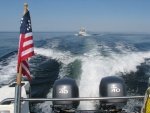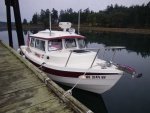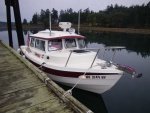One of the reasons that topic are often repeated, and tips are also repeated, is that we have a number of new C Dory owners. The boats handle a bit differently than many other boats. We should never discourage questions and learning by new members.
A couple of other thoughts: Always stop and shift the boat before coming into a tight situation. (That is one I learned from experience, when I had the shifter cable securing clip come off of the transmission in a 65,000 #, 62 foot boat!--fortunately no damage, but a lot of sweat!)
A trick I have often repeated is to practice away from a dock. Tie two fenders to a boat hook, and drop it over the side. practice "docking" along side the two fenders--both sides, stern too, and bow too. Also you can set up a slalom course with several fenders if you need to practice short turns. Set up several fenders in shoal water, with weights holding the fenders in place.
Also there are going to be times, when it is better to back into a slip. Especially when you have to go into the wind--the bow will fall off, and the boat can be more accurately steered in reverse.
One other trick not mentioned in docking, is the use of spring lines.
A comprehensive book on docking is by Charles T Low (MD). The book is out of print, but copies are still available on Amazon. Here is a link of an article by Dr. Low,:
http://boatsafe.com/nauticalknowhow/bdock.htm
Although many of the books are written for inboards, there are many common maneuvers which are similar with outboards.
Over 90% of my personal docking experience is with inboard sailboats, where a big rudder is a real advantage.



